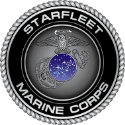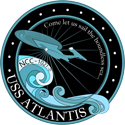 USS Minuteman Specs
USS Minuteman Specs
Registry Number: SRV-101
Class: Minuteman
Classification Type: Strategic Reconnaissance Vehicle
Dedication Quote: “Arma virumque cano…”
Date of Commission: September 9th, 2395
First Commander: Brigadier General (Then Colonel) Douglas McKnight
Current Commander: Lieutenant Colonel Rak’nar
Length: 332 meters
Width: 150 meters
Height: 85 meters
Displacement: 850,000 metric tons
Complement: 115 crew. 36 marine strike force embarked.
Current Berth: Fort Kościuszko. Mobile installation, current location classified.
Tactical Systems:
– 10 recessed phaser turrets, 8 nacelle mounted, 2 ventral.
– 1 forward fixed lance phaser
– 8 torpedo tubes, 4 fore, 4 aft. Complement, 120 Mark II Advanced Spatial Torpedoes
– 16 Mark III long range tricobalt missiles. Effective range, 20 light years.
Speed:
Optimum cruising speed: Warp 7
Maximum cruising speed: Warp 9.975
Emergency speed: Warp 9.9985
Slipstream capable
Stealth Systems:
– Active emissions containment and concealment. Requires periodic heat venting.
– Sensor absorbing alloys built into hull, thickest around power plant and inhabited areas
– Readily configurable warp field geometry. Sizable library of known patterns pre-loaded for emulation.
Deck Layout:
Deck 1: Bridge, Captain’s Quarters/Ready Room
Deck 2: Captain’s dining room, Senior Officers’ quarters, Emergency stores, Weapons lockup 1
Deck 3: Sickbay, Mess Hall, Holodecks 1&2, Medical Storage, Computer Core, Transporter Room 1
Deck 4: Officer bunks, Crew bunks, Gymnasium, Main Armory, Transporter Room 2, Emergency stores, Computer Core, Warp Cores
Deck 5: Torpedo magazine, Main engineering, Warp Cores, Computer Core, Missile Bays
Deck 6: Deuterium storage, Auxiliary control center, Crew bunks, Weapons lockup 2, Transporter Room 3
Deck 7: Upper cargo storage, Backup fusion reactors
Deck 8: Lower cargo storage, launch bay
History:
In many respects, the Minuteman Class starship can be seen as the Marines’ answer to Starfleet’s Defiant Class, and subsequent designs aimed at combating the Borg. There’s not much apparent visual similarity, but regardless, all these new designs represented the acknowledgement of a rapidly changing galaxy, in which not all those changes were for the better. Just as the 2360s and 70s had shocked the status quo with the emergence of large scale, existential threats in the Borg and Dominion, the closing decades of the century bore witness to an alarming proliferation in smaller scale but more frequent upheavals on the frontier of Federation space. The Crystalline Conflict which erupted seemingly out of nowhere in late 2382 gave way to the Machen Bren War a few years later. The Hinterlands Conflict with the Free Fleets pirates led into the Second Tzenkethi War. Some of these conflicts, at times involving dozens of ships and tens of thousands of personnel in a single engagement, stretched the usual definition of “small scale” and strained Starfleet’s ability to adequately respond. And as the frontier’s advance continued to accelerate, particularly after the emergence of Quantum Slipstream Drive as an ever more common feature of Starfleet vessels, this volatility was only projected to get worse.
The Marine Corps’ involvement in all of these incidents was extremely limited, owing largely to a somewhat conservative deployment strategy which corresponded to a politically mandated drawing down of their numbers after the Dominion War. In effect, they had been kept in reserve as an emergency response force, kept in a high state of readiness at pre-appointed staging areas and awaiting the call to action. This might have worked fine if the emergencies had arisen anywhere remotely near the Federation’s core worlds, but in reality, it meant that the only marines able to respond in a timely fashion were those already deployed by special request on Starfleet vessels. This quickly led to a growing dissatisfaction among both the Marine brass, who felt their potential was being squandered. A more flexible approach, centered around a more precise and proactive use of force, could potentially deal with some of these simmering trouble spots before the situation erupted into full blown war. For this, however, they’d require a substantial recruiting effort to rebuild their manpower base, and they’d require specialized equipment.
They’d need their own ships.
A decision was quickly made to avoid the traditional Starfleet R&D and manufacturing processing, instead deciding to approach alternate contractors after discreet but thorough security evaluations. For one, they wished to delay general knowledge of this new fleet’s existence, much less its capabilities. Secondly, the marines had a completely different set of design priorities. Whereas traditional Starfleet ships emphasized a capacity for long duration voyages and versatility in their mission profiles, these new ships were intended for something very specific: Get on site quickly, avoid detection, and proceed to either observe or decisively intervene as the situation dictated. Thus, as with the Defiant, the official designation which appeared on internal paperwork was a euphemism. Officially dubbed a “Strategic Reconnaissance Vehicle”, this thing was to be nothing less than a purpose built raider.
The stealth requirement was accomplished by digging up some admittedly classified designs already on file. An independent starship, Classification BC 011, formerly in possession of the mercenary Arctus Baran, had been impounded in 2370 and subsequently studied thoroughly by the Starfleet Corps of Engineers, with particular interest paid to the composition of its hull which had rendered it virtually invisible to long range sensors. Much more recently, the crew of the USS Atlantis had successfully tested an active emissions containment based stealth system which had proven similarly effective, without any actual violation of the Treaty of Algeron. Meanwhile, the very slipstream drive which had troubled military planners would give the ship all the speed it would need.
At the same time, the brass was wary of cramming too much cutting edge, and therefore resource and maintenance intensive technology into a single hull. Thus, priority was given to squeezing as much performance as possible out of more proven technologies as well. Thus, they also achieved record setting conventional warp speed with more of a brute force approach, mounting four oversized warp nacelles which accounted for roughly half the overall mass of the vessel. Looking backwards as well as forwards for solutions, they settled on a horizontal warp core, an older and thoroughly tested design. It wasn’t quite as efficient as the vertical collision models favored by Starfleet ships, but the relative simplicity of its operation and maintenance allowed for the option of running two of them simultaneously. The ship would be cramped, and its amenities would be basic, but by God, everything would work. In the end, everything from propulsion to armaments to aesthetics could be described by Federation standards as unorthodox, but effective.
The first ship of the class, U.S.S. Minuteman, emerged from Beta Aurigae shipyards in mid-2395, and met the usual fate of any ship destined for an interesting service life: It performed admirably in a role completely different from what its design team had anticipated. By that point, the attempted Section 31 takeover of the Federation was well underway. Realizing the peril just in time to act before his subsequent kidnapping and assassination, Lieutenant General Ahmad Tariq dispatched his adjutant, Colonel Douglas McKnight, with both the prototype and his own personal authority to take whatever action he deemed necessary to foil the plot. The Minuteman and its unique capabilities were instrumental in surreptitiously approaching the Atlantis crew to warn them of the danger and then assisting with the rescue of Admiral Ian Blackthorne and Captain T’Kirr, whose deaths Section 31 had been faked to cover their kidnapping. Finally and most dauntingly, Minuteman was tasked with penetrating Earth’s defenses on a mission to extract Admiral Alexi Zuriyev, former Commander in Chief of Starfleet and now a victim of telepathic brainwashing. The mission was successful, and Zuriyev was deprogrammed in time to bear witness against Section 31 when the coup was finally unraveled.
In the years that followed, Minuteman received a couple of upgrades, mainly aimed at enhancing its firepower as confidence in the design grew. However, it was also required to wear a number of different hats. While Marine fighter wings had existed for some time, crewing their own warships was a task without precedent for them, and it was initially somewhat of a chore to train up enough personnel to crew Minuteman’s sister ships as they emerged from their berths. Thus, in addition to performing its regular missions, she would see a constant rotation of crew, command staff included, in its capacity as a training ship. Only in the past few years, as more ships have appeared to assist with the training role, has this rotation slowed to a pace necessary to manage crew fatigue. Rak’nar of House K’tan became the vessel’s first long term CO as of August 14th, 2399.
